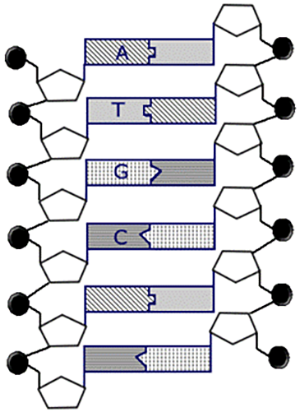Reinforcement: The Molecule of Heredity (DNA)
1. A nucleotide is made of three parts: a ___________________ group, a five carbon __________________, and a nitrogen containing _____________________
2.The sides of the DNA ladder consist of alternating ______________ and phosphates.
3. The 5’ end of a single DNA strand contains a free __________________, while the 3’ end contains a free __________________________.
4. Chromosomes consist of DNA wrapped around _________________________.
5. DNA was not thought to be the genetic blueprint originally; instead many scientists hypothesized that _______________________ contained the genetic code and blueprint of life. (They were later proven wrong.)
6. Purines have _________ rings, and pyrimidines have ____________ ring.
7. Check each of the following statements that are true with regard to Griffith’s experiments.
a. ______ Griffith discovered transformation in bacteria.
b. ______ Mice injected with smooth bacteria quickly became sick and died.
c. ______ Encapsulated bacteria can become “naked” bacteria.
d. ______ Bacteria that do not have capsules tend to be harmless.
e. ______ Smooth bacteria develop a capsule only after exposure to the DNA of encapsulated (rough) bacteria.
f. ______ Griffith’s transforming factor was the protein in the capsule.
g. ______ Transformation allows bacteria to acquire new genes.
h. ______ Enzymes that destroyed DNA would prevent transformation.
8. Check each of the following statements that are true with regard to the Hershey-Chase experiment.
a. _______ DNA was labeled with radioactive phosphorus.
b. _______ Protein was not labeled.
c. _______ Radioactive sulfur was found in the offspring phages after they emerged from the cell.
d. _______ Phage proteins were not transmitted to host cell or to offspring.
e. _______ New phages contained radioactive phosphorous in their DNA.
9. Chargaff’s rule states that the DNA of any species contains equal amounts of ______________ & ____________ and also equal amounts of _________________ & __________________
10. In DNA, thymine is complementary to ________________ ; cytosine is complementary to _____________
11. In a strand of DNA, the percentage of thymine is 30 %. What is the percentage of cytosine in the same DNA strand? _________________
12. Number the steps of DNA replication in the correct order (1, 2, 3)
_______Polymerase travels down the DNA parent strand from the 3’ to 5’ direction.
______ DNA unwinds
______ Ligase binds okazaki fragments together
13. Why is DNA replication called “semi-conservative”? ________________________________
14. What enzyme unwinds or unzips the parent strand? ________________
15. The junction between separated strands is called the ________________________________
16. What enzyme synthesizes the new DNA strand by adding bases? _______________________
17. What enzyme binds fragments of DNA on the lagging strand? ______________________
18. DNA polymerase only travels in the ________ to _________ direction.
19. On the diagram:
Label the 3’ and 5’ ends.
Circle a nucleotide.
Label the sugar and phosphate.
Label the bases that are not already labeled.
20. The two sides of the DNA helix are held together by ________________________
21. Write out the complete name for DNA: __________________________________________
22. Name the scientist(s) responsible for each of the following discoveries.
_____________________________________ Bacterial transformation
_____________________________________ The base-pair rule
_____________________________________ DNA was the hereditary material of viruses
_____________________________________ Determined the shaep of DNA from X-rays
_____________________________________ Established the entire structure of DNA
Other Resources on DNA
Coloring DNA – basic image of DNA and RNA for students to color following directions; includes questions and analysis
DNA Crossword – puzzle to practice basic terms related to DNA
DNA Mutations Using Protein Synthesis Simulator – Connected Bio resource which shows how proteins change when a base is changed
Protein Synthesis Practice - use a codon chart to determine sequences of amino acids
Transcription & Translation Coloring - shows structures involved, nucleotides, base pair rules, amino acids





